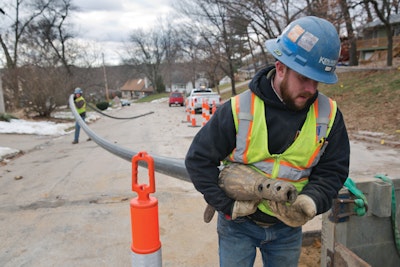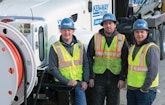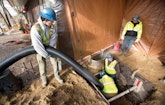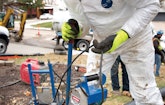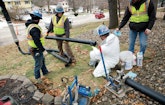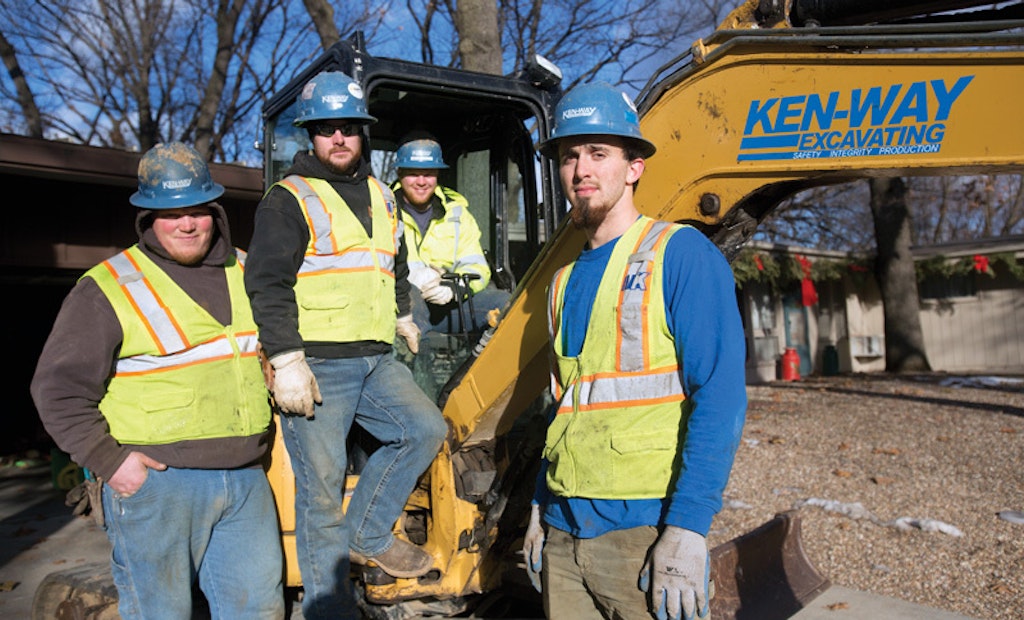
Interested in Systems/ATUs?
Get Systems/ATUs articles, news and videos right in your inbox! Sign up now.
Systems/ATUs + Get AlertsThe three partners who bought Ken-Way Excavating were looking for a niche in the onsite installing market. They found their specialty in pipe bursting to replace existing septic service lines.
Getting the job done underground saves on fuel consumption over using traditional excavation, extending the work season in their frosty territory around Cedar Rapids, Iowa, and making customers happy by limiting the mess left behind by trench work.
Charlie Fisher, who owns Ken-Way with brothers Dan and Pat Zamastil, saw the technology as popular in other parts of the country and wanted to bring its advantages to Iowa.
“I came home to Iowa from Denver and there were sewer companies doing it there on a daily basis,” he says. Although he had not seen the technique used for onsite installations, he realized that the pipe between a home and a tank was no different than the lateral from a home to a sewer collection main. And the idea can be extended to include pipes that carry water or natural gas.
Two months into the partners’ ownership of Ken-Way in March 2010 they purchased pipe bursting equipment, and it is often employed in the up to 30 onsite systems they install annually.
The work ranges from simple gravity systems, perhaps with a sand filter, to those utilizing Ecoflo Biofilters (Premier Tech Aqua) for more limiting sites.
Bursting Out
Currently Ken-Way uses pipe bursting equipment from HammerHead Trenchless Equipment. For replacing 4-inch pipe they have a PB30. It’s a small machine suited for tight spaces. Machines of other sizes handle larger sewer main work. And although typical demonstrations or online videos show equipment bursting clay pipe, it can do more. Technicians join HDPE SDR-17 replacement pipes using a system from Connectra Fusion Technologies.
“We can burst plastic, cast iron, ductile iron and transite pipe,” Fisher says.
Not every job is perfect for bursting. Replacing pipe of one diameter with new pipe of the same diameter — in other words 4-inch with 4-inch — is typically less challenging. When the replacement is a larger diameter, the volume of soil displaced may become an issue, Fisher says.
“In denser soils there may be a problem bursting a 6-inch clay main to upsize it to a 10-inch,” Fisher says.
Sandy material is easier to displace than glacial tills, but hard-packed sand could also pose a challenge. Problems come from the usual arrangement on job sites where other utilities are often located near wastewater pipes. It’s those other pipes that may be affected by displaced soil. It doesn’t always happen, but it is a situation you have to think of and be prepared for, Fisher says.
Other preparation is required for bursting. Every line is televised before and after the job. A pipe with an offset joint or a pipe that is collapsed can be replaced. A pipe with a long sag or belly is not a candidate for replacement because the lack of proper bedding will create a belly in the new pipe just as it did in the old one. After the work is done, Ken-Way televises the line again to ensure the job has been done properly.
Many Advantages
Where it can be used, bursting is much better than digging a trench, Fisher says.
“Why would you have an open trench 60 feet long when you can have two pits? You can prep two pits safely, and you’re not dragging a trench box along. For a pipe replacement, bursting takes about the same amount of time but it is much less dangerous for the men. Buying bursting equipment increases your costs, but that is offset by the reduced risk and by fuel cost because you don’t burn as much as you do when digging,” he says.
Customers are happier, too, because their property damage is less. In one situation, there was a run of several hundred feet from a house to its septic tank. The yard contained several trees, and the owners didn’t want the roots damaged by digging. Pipe bursting did the job and left only a couple of pits for restoration instead of a long trench.
Pipe bursting is also good in tight situations where an excavator arm cannot swing, even a mini-excavator. In one case a home had a large second-story deck. Instead of removing the deck, Ken-Way technicians set up the pipe bursting gear in the basement and replaced the pipe from there to the septic tank.
Using pipe bursting extends Ken-Way’s working year as well because there is less frozen soil to dig. The company’s hydroexcavator helps, too.
“We had a project on a cold December day last winter. The work site was too tight for an excavator. We brought in the hydroexcavator and hydraulic shoring. In four hours the crew cut a pit, and we were ready to set the pipe bursting equipment,” Fisher says.
“Even without the hydroexcavator we work through the winter every year. If it’s 10 degrees and rising, we’re going to go out and work. On days when the high is in the single digits, we cannot justify sending the guys out. In that kind of weather machines break and nothing goes right. Still, during the coldest January or February we typically take only a few days off,” he says.
We’re Cat Lovers
Except for a Yanmar excavator, all the equipment that Ken-Way operates is from Caterpillar. Their largest excavator is a 330F, and the smallest is a 303.5. In addition, the company has six Mack dump trucks (most carrying Henderson Products dump bodies) and a hydroexcavator from GapVax on a Peterbilt chassis.
Choosing Cat was easy, and part of the decision depended on the local dealer, Fisher says.
“When we bought the company, we created relationships with our equipment suppliers. In the last six years we made a lot of changes, and our Cat dealer took care of us. Whenever there’s a problem we can’t solve, all we have to do is pick up the phone, and it gets handled,” he says.
Plus, the resale market for Cat equipment is always strong, he says.
Ken-Way rotates equipment based on its records. Everything about each machine is tracked, whether it’s routine maintenance or a major repair. Each machine carries a number, and the partners can call up the record of a specific machine and see how much money has been spent on it over time.
Given experience with machines and their needs, this has led to a practice of trading some machines in every few years and others hardly ever. For example, bulldozers are built tough, Fisher says. Maintenance costs are minimal, and they’re expensive to buy, so Ken-Way holds on to its dozers as long as possible. Skid-loaders are a different story. They’re traded out at 2,500 to 3,000 hours because the company’s records show maintenance costs increase dramatically after that point.
Taking Care of Business
Dan Zamastil oversees the shop and the company’s equipment. If something breaks, the company’s workers know they need to call Dan. Much of the maintenance is done in-house, even a job like rebuilding a bulldozer. If a transmission goes out in one of the trucks, Dan makes the call to have an outside shop fix it. His brother Pat runs operations and scheduling. Fisher handles the administrative work, estimating and looking at contracts.
“What this does is take a load off everyone’s shoulders,” Fisher says. “You don’t have one person trying to make decisions on everything. We can assign a job to the right person, and we trust one another. We look on one another as brothers rather than partners.”
Building a good company also means building up a good workforce. Ken-Way doesn’t necessarily look for people with long experience in the industry. They seek a person who will mesh with the team and is willing to learn, because the right person can be taught the skills he needs to do a job.
“When we bought the company and began expanding it, we had to replace much of the staff and add to it,” Fisher says. “We now have a great group of guys. Many of them have been with us for a long time, and we have every intention of keeping them for a long time.”
Obviously competitive pay is a factor in employee retention, he says. On top of that the company offers a health insurance program, a retirement program with company matching, and the potential for annual bonuses. Every year the company conducts performance reviews with each employee. Workers are complimented on their improvements, and they have a chance to look at where they stand in the company and where they want to go.
Going places can also bring company assistance. If a technician wants to become a licensed plumber, Ken-Way will pick up the tuition cost for local classes. “We’re only as good as our team is, so paying tuition is an investment to us,” Fisher says.
Ken-Way is already a recognized brand with a good reputation, Fisher says. The company’s best marketing is its equipment, which is kept clean. Another factor is the company’s relationships with local plumbers. They refer business, as do Ken-Way’s previous customers.
Education is something Ken-Way also offers. Large real estate companies in eastern Iowa have invited Ken-Way to give 15-minute presentations for employees. For example, a presentation may cover how septic tanks work or what real estate brokers should look for in an existing system — age, type of system, pipe materials and so on — that may positively or negatively affect a buyer or seller.
In 2015, Ken-Way booked a venue and invited representatives of area engineering firms and municipalities to learn the basics of pipe bursting. Aside from their own people, Ken-Way brought in a representative from HammerHead and from a pipe manufacturer. One of the engineering firms in attendance subsequently hired Ken-Way for a large sewer replacement job, but the knowledge passed on at the workshop benefitted more than just Ken-Way.
Business Transition
The three partners grew up on the same street in the same town.
“We’ve been around the industry since we were kids, through family members, through high school, college, and after college,” Fisher says.
The previous owner of Ken-Way was a family friend, and when he was ready to leave the business, he approached Fisher and the Zamastils about buying it. They looked at the numbers, put together a plan, and settled the deal with a few phone calls. It was a good company in a niche market, and they decided they could build on that.
“It was a family septic, sewer and water business. We’ve just taken it to a much larger scale,” Fisher says.
They also brought many functions in-house. Rather than hiring trucks when needed, they bought the equipment so their schedules were not dependent on a subcontractor.
“We have expanded quite a bit, but we don’t depend only on growth. Our goal is growth and strength — being stronger within the niches we have developed so far,” Fisher says. That means emphasizing services such as hydroexcavation or pipe bursting that most excavation companies don’t perform for themselves.
“We don’t desire to get more dozers and excavators. Right now, if we get a call of a main pipe break, we can handle the job with our existing excavators and camera truck. If we identified a need for three more hydroexcavators in our area, that’s where we would rather grow,” Fisher says.
That does not mean that’s where they will grow. Every year is different, and next year the partners may take Ken-Way in another direction.
“What it comes down to,” Fisher says, “is you have to be ready to evolve with the opportunities that come before you.”
DIY Technology Focuses on the Necessitites
Charlie Fisher and his partners at Ken-Way Excavating like to keep everything in-house for more control and efficiency. The same idea is in play when it comes to the company's use of technology. There is QuickBooks for general accounting and tracking costs, but beyond that, Fisher likes to create his own custom templates.
"We use a lot of Excel spreadsheets, from estimating to a lot of our different forms that we've created in-house," Fisher says. "When I'm creating a daily job sheet for our guys, I know what I want it to accomplish. They can easily take it and use it, and I get exactly the information I need."
The same goes for big proposals. He can open his spreadsheet template and modify it as needed, perhaps with a different layout or with items specific to that job.
Technicians use paper copies of spreadsheets and fill in information by hand, whether it's a count of loads hauled or the amount of material used. Each sheet is coded by job.
"All the job sheets are customized. We have some only for guys driving dump trucks. Others are for guys doing hydroexcavating, jetting and cleaning. And there's another set for the technicians installing onsite systems," Fisher says.
At any time, he or his partners can bring up any job on his computer and see all the various costs for it. There are also separate codes for each type of service, such as commercial work or hydroexcavation.
"At any time I can pull a cost report and see how much we're making or losing on septic work specifically. If I want to go further, I can break it down by job."
